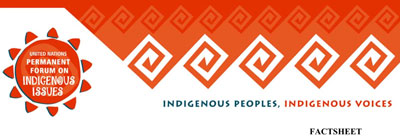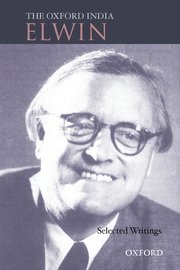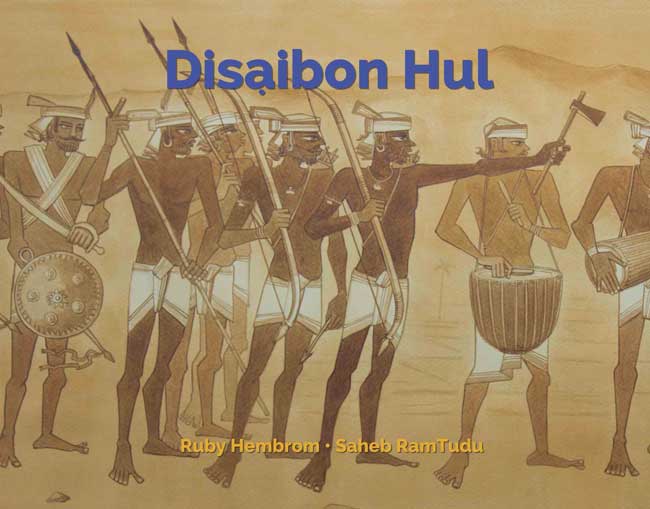
UN Permanent Forum on Indigenous Issues >>
Today, our world is experiencing a rapid decline in cultural diversity and the eradication of indigenous peoples and their lifeway. One in five people in the world speak the same language: Mandarin Chinese. Spoken by the largest single ethnic group in the world – the Han – whose 1.3 billion speakers represent 92 percent of the mainland Chinese population and 19 percent of the world’s population, while 235 languages make up the other 8 percent of China’s population. Likewise, in India – the world’s second most populous country – there are 415 living, recognized indigenous languages, but the majority of people speak either Bengali or Hindi. Around the world linguists recognize some 6,000 to 7,000 spoken languages, of which 5,000 or so are spoken by indigenous peoples who represent an estimated 6 percent of the world’s population.
Many of these indigenous people, their language, culture, and lifeways face a questionable future. The relatively rapid decline in language diversity parallels the decline in cultural diversity. These changes are due in part to the product of both historical relationships – imperialism, colonialism, global economic development, and militarism – as well as cultural beliefs that rationalize or justify actions that have served certain cultures at the cost of others. In many instances, this cost has been disproportionally sustained by indigenous peoples.
Indigenous Peoples Issues & Resources is dedicated to providing information, news, articles, videos, and resources for those concerned about, and for, indigenous peoples around the world. We recognize that our actions effect indigenous peoples in all parts of the world – the consequences of water diversion and hydroelectric energy projects, militarization, global and national events, consolidation of natural resource access, and the like are all having an unprecedented impact on the world’s indigenous peoples. But we can do something.
It is our belief that cross-cultural communication, cooperation, and understanding – as well as easily accessible information and resources – is one of the keys to helping indigenous peoples maintain their language, culture, and identity. We hope that you also share this belief. Diversity is one of the strongest components to a healthy world. Together we can help and make a difference – from large to small.
Source: Indigenous Peoples Issues and Resources
Address : http://indigenouspeoplesissues.com/
Date Visited: Sat Jun 30 2012 16:27:45 GMT+0200 (CEST)
In India, 40–50 per cent of those displaced by dam development projects were Adivasi tribal people.
Source: International: State Of The World’s Minorities And Indigenous Peoples 2012 – Indigenous Peoples Issues and Resources
Address : http://indigenouspeoplesissues.com
Date Visited: Sat Jun 30 2012 16:34:46 GMT+0200 (CEST)
Uncivilising the Mind: How anthropology shaped the discourse on tribes in India | Read the full article here >>
[…] By the 1940s in India, when considering how to incorporate tribal populations into the nation state, there was a division between two camps—one promoted “isolation” and “protection” against assimilation, while the other was for “intervention” and “assimilation.” Verrier Elwin and Ghurye broadly represent these opposite poles. Elwin, at least initially, supported protectionist policies and recommended the “partial isolation” of tribes from non-tribal society. Ghurye’s approach, on the other hand, proposed that tribes must embrace and speak the language of the neighbouring community and integrate into “advanced” societies.

Learn more about Verrier Elwin: Author and educator known for his work with the tribes of India >>
Despite their vast differences, anthropologists, including Elwin and Ghurye, as well as Srinivas and other Indian public figures and intellectuals, effectively erased or negated tribes’ worldviews and beliefs. When discussing the materialistic well-being of tribes, many anthropologists and other thinkers have also sometimes perpetuated a “saviour complex,” portraying tribes as bereft of the agency to express their own aspirations, and seeing it necessary to salvage tribal people from the clutches of their insubstantial living conditions without a deep consideration of how their ways of life have thrived in the past. […]
The word “tribe” itself, in fact, has always been a contentious term. Due to the lack of an adequate term, indigenous people chose to adopt it to identify their place in the world. The narrative is changing today. I cannot speak to contemporary writings from central and peninsular India, but in a sharp contrast to how intellectuals have ignored tribes’ cosmology and other beliefs, contemporary authors such as Arkotong Longkumer, in his book Reform, Identity and Narratives of Belonging: The Heraka Movement in Northeast India, and John Thomas, in Evangelising the Nation: Religion and the Formation of Naga Political Identity, have written about the Nagas at length and recognised tribal indigenous religions and the creation stories of the Zeliangrong Naga. In Anthropological Perspectives on Indian Tribes, another insightful book published last year, the anthropologist Subhadra Mitra Channa writes that people categorised as tribes are not merely remnants of a static past. She reminds us that tribal religions and customary laws are as relevant as organised religions and institutionalised laws in modern society, and refers to the morungs of the Nagas, the dhumkuria of the Santals and the gotuls of the Gonds as equivalents to schooling systems in mainstream societies. She also suggests that tribes are separate from Hindu society (except for tribes such as the Bhotiya, Rajputs living along the Indo-Tibetan border). Channa argues that implicit to theories such as Sankritisation is an evolutionary approach towards tribes, implying that there is a ladder towards attaining higher status under the fold of caste Hindus. This erases the history of “domination, and of hierarchies within politics,” between tribes and others.
Tribes are people with a functional social order, culture, customs, cosmology and metaphysics. They must be treated as any other contemporary people. I attempt to question the representation of tribes so far, and also try to foreground the intrusive ways in which assimilation was foisted upon tribes. The writer Ruby Hembrom, who is the founder of Adivaani—a publisher of Adivasi writing—told me that engaging with the writing of anthropologists writing about tribes is “a call to tribal conscience to address these [writers] head-on, without fear, as a way of setting records straight and challenging the primitivism they’ve thrown at us as exotic uncultivated people. This is finally exercising our agency to assert our true identities; a way to liberate the image and reputation of our ancestors and ourselves that has been chained to dehumanization by these writings’ imposed impressions of us.” […]
Source: “Uncivilising the Mind: How anthropology shaped the discourse on tribes in India” by Richard Kamei (Caravan Magazine, 1 March 2020)
URL: https://caravanmagazine.in/books/anthropologists-tribes-india
Date Visited: 20 November 2021
[Bold typeface added above for emphasis]
Tribal languages are a treasure trove of knowledge about a region’s flora, fauna and medicinal plants
“Tribal languages are a treasure trove of knowledge about a region’s flora, fauna and medicinal plants. Usually, this information is passed from generation to generation. However, when a language declines, that knowledge system is completely gone.” – Ayesha Kidwai (Centre for Linguistics, School of Language, Literature and Culture Studies, Jawaharlal Nehru University, New Delhi) quoted by Abhijit Mohanty in “Seven decades after independence, many tribal languages in India face extinction threat” | Learn more about the work done by the People’s Linguistic Survey of India and endangered languages worldwide >>
“The notion of ‘mainstreaming’ needs to be challenged not just because Adivasi culture is being crushed, but also because Adivasi values and ways of life offer insights that the ‘mainstream’ needs. If we are to halt the destruction of ecosystems, we need to understand how closely biodiversity and cultural diversity are intertwined. Perhaps it is time to reverse the gaze and begin to learn afresh from Adivasis.” – Felix Padel & Malvika Gupta (The Hindu) | Learn more about the role of tribal communities in fostering biodiversity, ethnobotany and cultural diversity | Success stories | Tribal identity >>
“I think that by retaining one’s childhood love of such things as trees, fishes, butterflies and … toads, one makes a peaceful and decent future a little more probable, and that by preaching the doctrine that nothing is to be admired except steel and concrete, one merely makes it a little surer that human beings will have no outlet for their surplus energy except in hatred and leader worship.” – George Orwell | Learn more: Childhood | Customs | Games and leisure time | Literature – fiction | Storytelling >>

Hul (Santal rebellion 1855-1856) | Santal Parganas | Tribal freedom fighters >>
See also
Adverse inclusion | Casteism | Rural poverty
Demographic Status of Scheduled Tribe Population of India (Census figures 2011)
Fact checking | Figures, census and other statistics
Human Rights Commission (posts) | www.nhrc.nic.in (Government of India)
Search tips | Names of tribal communities, regions and states of India
“What is the Forest Rights Act about?” – Campaign for Survival and Dignity
“Who are Scheduled Tribes?” – Government of India (National Commission for Scheduled Tribes, NCST)
Indian tribal cultural heritage: museum collections, eBooks, maps & more
Anthropological Survey | Anthropology
Books on tribal culture and related resources
Crafts and visual arts | Homes and utensils Crafts and visual arts | Masks
Cultural heritage | Revival of traditions
Dress and ornaments | Fashion | Tattoo
eBook | Background guide for education
eBook | Free catalogue: Banam: One of the ancient musical instruments of the Santals – West Bengal
eBook | Free catalogue: Museum of Santal Culture (Bishnubati) – West Bengal
Games and leisure time | Martial arts
India’s 28 States and 8 Union Territories – From Andhra Pradesh to West Bengal
Tribal customs, homes and ornaments in South India: Videos and photographs by Vicky Lakshmanan
Tips for using interactive maps
Toggle to normal view (from reader view) should the interactive map not be displayed by your tablet, smartphone or pc browser
For details and hyperlinks click on the rectangular button (left on the map’s header)
Scroll and click on one of the markers for information of special interest
Explore India’s tribal cultural heritage with the help of another interactive map >>